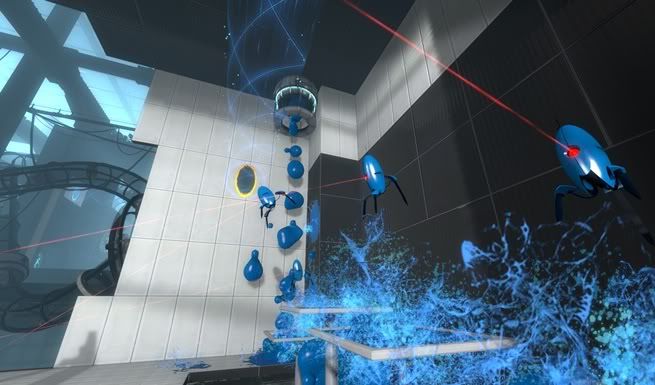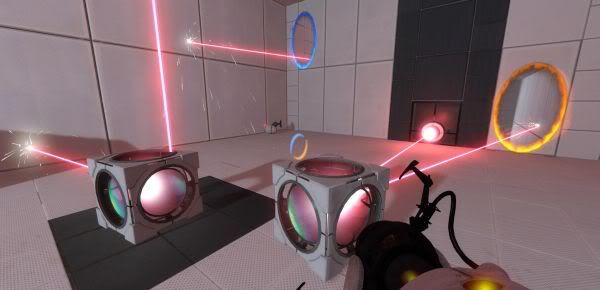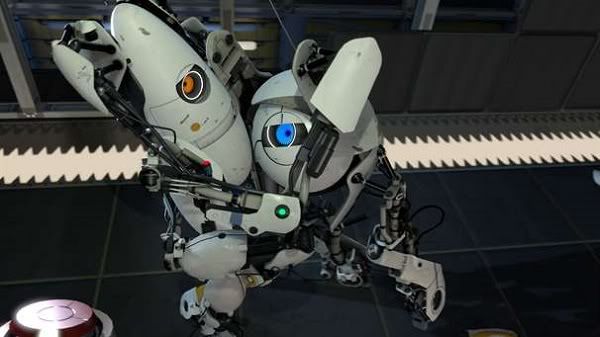Back in 2007 Valve released The Orange Box unto the world, a device used to push some of Valve’s previous games as well as some new ones, one such game in this compilation was the hidden gem of the package - Portal. No one knew what to expect from Portal and it ended up being the surprise favourite, with its dark humour, good atmosphere, clever puzzles and the amazing character of GLaDOS, it became a huge talking point amongst gamers and has remained a staple of great games design.
Now a few years on Valve has released Portal 2, this time as a standalone game which some people doubted at first because if it was much like the first game, although amazing, wondered if it would be worth the full price of a retail release. Well I can safely say that these fears are not needed as the sequel outdoes the first and keeps on going, Valve shows us once again that they are one of the leading developers for a reason.
 |
| The coloured gels in this game are awesome additions, if only for the above use. |
Portal 2 retains all of the mechanics that were a part of the first game; you of course have your trusty portal gun, which fires two different coloured portals that represent either side of a doorway, buttons that you will more often than not have to use the weighted cubes to hold down, as well as all of the physics from the first game such as retained velocity when travelling through portals. Using these mechanics the player will be given a puzzle room to solve, and when complete can move to the next room.
Along with all of this, the game introduces many new mechanics into the game that both help to increase the complexity for the puzzles, as well as adding more variety. This includes three different coloured gels that are orange, blue and white which make you speed up, bounce and create portal surfaces respectively. Other new mechanics are things such as redirection cubes, that will change the direction a laser is going in (often needing to be directed to a laser switch), hard light surfaces which are bridges that can be used to walk on or block projectiles, excursion funnels which act like a tractor beam and aerial faith plates that launch you in a specified direction.
While this does sound like a hell of a lot of new mechanics to get into, Valve have been smart not to have too much going on in one room, often featuring no more than three or four different things to keep track of at once. By having so many varying puzzle types it helps to keep the game feeling fresh, since as soon as you are starting to find one mechanic a bit tiring the game will then switch it up and offer you new ways to do things. This is a hard balance to keep considering the longer length of the game and is very well done.
Speaking of game length the single player campaign took me around 8 hours to complete. I don’t really want to speak too much about the specifics of the campaign as it really is best left for you to discover for yourself, just know that the game has some amazing new characters introduced, with all of them having great voice acting, not one line in the game sounded weird or wrong. The game also has brilliant pacing in that it will switch up the puzzle type or area style just when it needs to and also has much greater narrative and direction that the game follows compared to the first game.
 |
| Lasers are cool, so in turn laser puzzles are cool, right? |
Speaking of game length the single player campaign took me around 8 hours to complete. I don’t really want to speak too much about the specifics of the campaign as it really is best left for you to discover for yourself, just know that the game has some amazing new characters introduced, with all of them having great voice acting, not one line in the game sounded weird or wrong. The game also has brilliant pacing in that it will switch up the puzzle type or area style just when it needs to and also has much greater narrative and direction that the game follows compared to the first game.
Following on directly from the end of the single player is the co-op campaign; the idea of this is completely new to the series and is fairly well executed despite there being a couple of nitpicky issues that I had. In co-op player 1 and 2 play as two different robots named Atlas and P-Body respectively, each player has their own portal gun that shoot separate portals, therefore some working together is required to coordinate them. The robots also have a variety of humorous commands they can execute such as dancing, hugging or playing rock paper scissors to see who gets to risk their life first. The campaign is split up into different testing areas that can be reached via a hub world that you start in, with each area following a different theme (such as hard-light bridges or excursion funnels) and containing around 10 tests each. While this works well to cut the game into sections, I wish that they would’ve varied the areas a bit more, such as having the tutorial tests for each mechanic in one area then mixing up the tests for the remaining areas. The entire co-op campaign took us roughly 5 hours to complete, which is a decent length as it is more room to room challenges, rather than following a narrative like the single player.
 |
| What you don't see here is the emote where they tear eachothers heads off..... |
TL;DR
In summary the game triumphs over the first in every single area, creating one of the most enjoyable games I have played, and with the co-op mode you have the added bonus of being able to argue over puzzle solutions with a friend while attempting to work together (which is a good thing), making a great addition to the single player campaign available. Although there will still be doubts of paying full price for what at least for myself was a 13 hour game with pretty much no replay value, I think that it makes up for it in character and pure enjoyment.
4/5

No comments:
Post a Comment